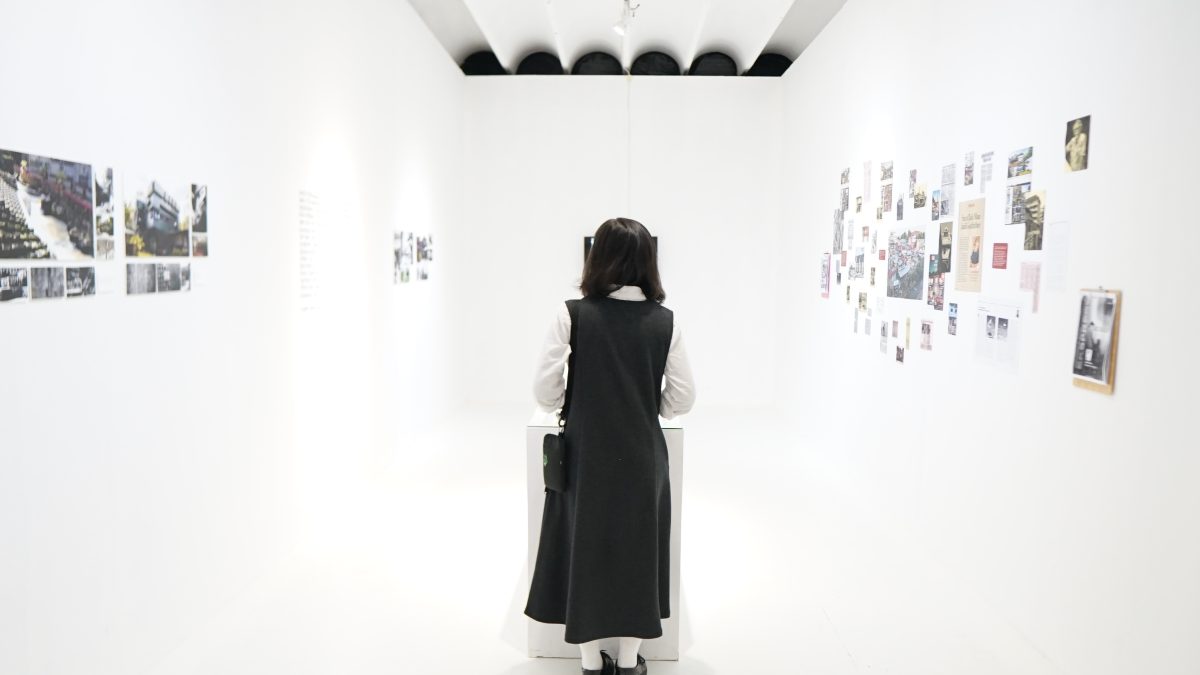
“The Catholic Church in Asia is the church of the poor. It’s not that we are hostile to the rich, but we sided with the needy because they have no way out!”
“Women are the most colonized human being, the ones suffering the most. The theory may say otherwise, but it is fact that women are in that position. And I have an instinct to side with the colonized.”
The quote can be read in the Main Exhibition Room of the Biennale Jogja XVI Equator #6 2021. On the second floor on the west side of the Jogja National Museum (JNM) building, there are two special rooms dedicated to Yusuf Bilyarta Mangunwijaya, with who we are familiar as Father Mangun, although we’ve never met nor gotten acquainted before.
The A Room contains books, clippings, and video interviews, the B Room contains more quotes, architects’ work, and two books. The rooms did feel different compared to the artworks displayed elsewhere, but on the other hand, Father Mangun’s greatness felt too small in them. The room will feel empty if we miss the details on the archives shown there. Just a little bit of advice, you should stay inside longer.
The two quotes above at least gave us a picture of Father Mangun’s social, political, and religious views. We could summarize it into one word: humanity. This attitude of Father Mangun was consistently articulated in various media that’s close to the people. We could at least see it in several fields, such as religion, education, architecture, and literature.
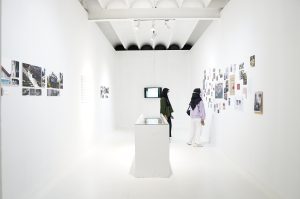
For Father Mangun, education is one of the means to form one’s identity and maturity. Thus, an education that does not give freedom to students and only conveys the values of the majority will not produce “humanity” because humans are animal rationale. We are creatures who have morals. Beings who can think, make choices, and then act based on said choices. This is what we then call a free man. And this independence should have been achieved since childhood.
At least this is what we can see through the Mangunan experimental school that focuses itself on the first three levels of school: elementary, junior high, and high school. In addition to the light basic rules, almost all school policies are determined jointly between the school and the student’s guardians. One of the examples is the school fees. Each student’s fees can be different, depending on their economic abilities. There is only one uniform and it is worn on Mondays, the rest of the week, the students can wear anything as long as they dress modestly.
Likewise with the teaching method. This school emphasizes the ability of students to explore knowledge as life science. The learning atmosphere is created to be as fun as possible so the students can easily absorb knowledge.
We can regard this school type as Father Mangun’s partiality towards the poor who had a hard time accessing education, and also to education that doesn’t indoctrinate the students, but “liberate” them instead. Years later, this type of education would be classified as an “expensive” one.
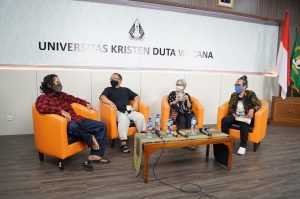
If lliterature was merely an intermezzo in Father Mangun’s life, there wouldn’t have been many works that he produced. He has published at least 36 works in the form of essays, short stories, and novels. His masterpiece, Burung-burung Manyar or The Streaked Weavers, was awarded the Ramon Magsaysay Award in 1996. This fiction differs from its fellow revolution era stories depicting heroes and enemies, but rather questions how a human being faces life with all its complexities, from where they start to which way they go (sangkan
paran).
In Burung-Burung Manyar, social classes are distinctly depicted through two characters who fell in love with each other but have different life choices. However, Father Mangun does not present them as a contradiction, but as part of the complexity of life to find their identity.
We can also see a similar depiction in Burung-burung Rantau or Migrating Birds that tells the story of the middle class, and in the Balads of Rickshaw, a story about the poor, excluded and marginalized lower class.
We also have to question the reason why Father Mangun made Roro Mendut into a novel. This character is used to express his instinct to defend the oppressed and fight against male domination. In his trilogy, Roro Mendut, Genduk Duku, and Lusi Sindri are three women who fight for their own fates, which shows Father Mangun’s partiality towards women.
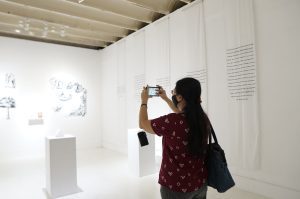 Inside the B Room, several mock-ups of Father Mangun’s architecture works were presented, which were then linked to the main theme of the Biennale Jogja XVI exhibition, Oceania. On one side of the room were two books, Ikan-ikan Hiu, Ido, Homa and Menuju Republik Indonesia Serikat or Towards The United States of Indonesia by Father Mangun. On the other side were several quotes, two of which can be read at the beginning of this article.
Inside the B Room, several mock-ups of Father Mangun’s architecture works were presented, which were then linked to the main theme of the Biennale Jogja XVI exhibition, Oceania. On one side of the room were two books, Ikan-ikan Hiu, Ido, Homa and Menuju Republik Indonesia Serikat or Towards The United States of Indonesia by Father Mangun. On the other side were several quotes, two of which can be read at the beginning of this article.
If asked about architecture, Father Mangun said there’s no particularly serious problem in the field. The architect makes a signified which is then realized in the form of signifier by a handyman. However, in the hands of Father Mangun, architecture finds its momentum and meaning.
One of the most talked-about cases of Father Mangun is the Kali Code (Code River) complex, which Father Mangun successfully transformed into an attractive settlement. The place was originally a garbage dump. The houses were made of used cardboard, gedhek or walls from bamboo weaving, and plastic waste. In 1984, Father Mangun came and initiated the settlement into a complex fit for people to live in.
Code River wasn’t chosen solely because of its location, but also the people living on the river banks needed his guidance. They worked as beggars, scavengers, pickpockets, to sex workers. Father Mangun’s number one priority was changing the negative stigma surrounding the residents. Through architecture, Code River became a settlement that breathes humanity.
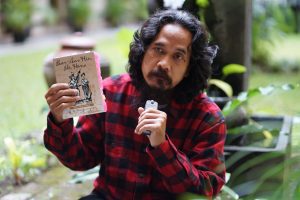 As stated earlier, the two rooms dedicated to Father Mangun were too small to contain his greatness if the images of knowledge built within those spaces don’t permeate within you. And feeling that it’s still not enough, the curator of the exhibition, Ayos Purwoaji, also organized Sinau Romo Mangun (Studying Father Mangun) through the book Ikan-ikan Hiu, Ido, Homa.
As stated earlier, the two rooms dedicated to Father Mangun were too small to contain his greatness if the images of knowledge built within those spaces don’t permeate within you. And feeling that it’s still not enough, the curator of the exhibition, Ayos Purwoaji, also organized Sinau Romo Mangun (Studying Father Mangun) through the book Ikan-ikan Hiu, Ido, Homa.
The book became the main curriculum literature in every class that’s held once a week. The Biennale Jogja XVI collaborates with the Laboratory of History, Theory, Technology Studies and Design of FAD UKDW (Jogja), Bilik Literasi (Colomadu), Hatopma Publisher (North Bengkulu Regency), Basic Education Dynamics Foundation (Jogja), and Pusat Dokumentasi Arsitektur (Jakarta) to organize it.
24 class participants intensely read Ikan-ikan Hiu, Ido, Homa and wrote reviews of the book. A few examples of the resulting emerging topics were issues regarding religion, children, weaponry, lifestyle, and so on. The participants’ writings will be recorded and launched at the end of the Biennale Jogja XVI.
Ikan-ikan Hiu, Ido, Homa itself is a historical novel set in the 16s to 17s portraying the cultures of the people of Halmahera, North Maluku, with the Tobelo Tribe. It was apparent in the novel that Father Mangun was partial towards the colonized locals, oppressed by the arbitrary practices of the Portuguese, Spanish, and Dutch.